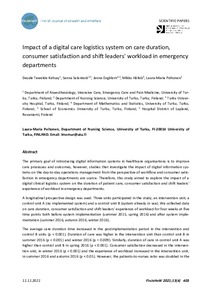Impact of a digital care logistics system on care duration, consumer satisfaction and shift leaders’ workload in emergency departments
Tewelde Kahsay Desale; Salanterä Sanna; Engblom Janne; Häikiö Mikko; Peltonen Laura-Maria
https://urn.fi/URN:NBN:fi-fe2022012710737
Tiivistelmä
The primary goal of introducing digital information systems in healthcare organisations is to improve care processes and outcomes, however, studies that investigate the impact of digital information systems on the day-to-day operations management from the perspective of workflow and consumer satisfaction in emergency departments are scarce. Therefore, this study aimed to explore the impact of a digital clinical logistics system on the duration of patient care, consumer satisfaction and shift leaders' experience of workload in emergency departments.
A longitudinal prospective design was used. Three units participated in the study; an intervention unit, a control unit A (no implemented system) and a control unit B (system already in use). We collected data on care duration, consumer satisfaction and shift leaders' experience of workload for four weeks at five time points both before system implementation (summer 2015, spring 2016) and after system implementation (summer 2016, autumn 2016, winter 2016).
The average care duration time increased in the postimplementation period in the intervention and control B units (p < 0.001). Duration of care was higher in the intervention unit than control unit B in summer 2016 (p < 0.001) and winter 2016 (p = 0.009). Similarly, duration of care in control unit A was higher than control unit B in spring 2016 (p < 0.001). Consumer satisfaction decreased in the intervention unit, in winter 2016 (p < 0.001) and the experience of workload increased in the intervention unit, in summer 2016 and autumn 2016 (p < 0.05). However, the patients-to-nurses ratio was doubled in the intervention unit in the last time point postimplementation when compared to the first timepoint, while it remained similar in the control units throughout the study period.
This work demonstrated that a digital care logistics system may support in increasing the number of patients treated with the same nursing resources. However, this seems to connect to other outcome variables such as increased care duration, increased experience of workload and decreased consumer satisfaction in some postimplementation time points.
Kokoelmat
- Rinnakkaistallenteet [27094]
